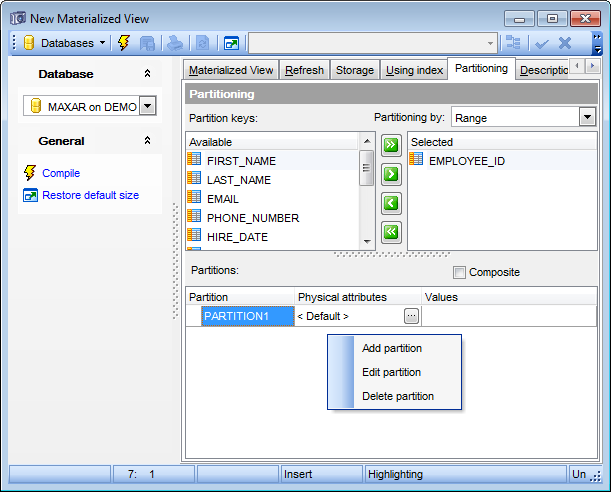Online Documentation for SQL Manager for Oracle
Partitioning
The Partitioning tab is provided for setting up partitioning parameters for a partitioned materialized view. It appears when the ![]() Partitioning option is enabled at the main tab of the editor.
Partitioning option is enabled at the main tab of the editor.

Partitioning by
Range
Select this item to partition the materialized view on ranges of values from the column list. For an index-organized materialized view, the column list must be a subset of the primary key columns of the materialized view.
Hash
Select this item to specify that the materialized view is to be partitioned using the hash method. Oracle Database assigns rows to partitions using a hash function on values found in columns designated as the partitioning key.
List
Select this item to partition the materialized view on lists of literal values from column. List partitioning is useful for controlling how individual rows map to specific partitions.
Partition keys
Use this group to specify an ordered list of columns used to determine into which partition a row belongs. These columns are the partitioning key.
To select a column, you need to move it from the Available list to the Selected list. Use the ![]()
![]()
![]()
![]() buttons or drag-and-drop operations to move the columns from one list to another.
buttons or drag-and-drop operations to move the columns from one list to another.
![]() Composite
Composite
If this option is selected, the materialized view is first partitioned by range, and then the partitions are further partitioned into range, hash, or list sub-partitions.
Sub-partition keys
Use this group to specify an ordered list of columns used to determine into which sub-partition a row belongs. These columns are the sub-partitioning key.
To select a column, you need to move it from the Available list to the Selected list. Use the ![]()
![]()
![]()
![]() buttons or drag-and-drop operations to move the columns from one list to another.
buttons or drag-and-drop operations to move the columns from one list to another.
Sub-partitioning by
Use the drop-down list to indicate the type of sub-partitioning you want for each composite range partition: hash or list.
Partitions
This area allows you to specify individual partitions. Right-click within the list area to call the context menu allowing you to create a new partition, edit or delete the selected partition.
Values
Specify the non-inclusive upper bound for the current partition. The value list is an ordered list of literal values corresponding to the column list.



































































